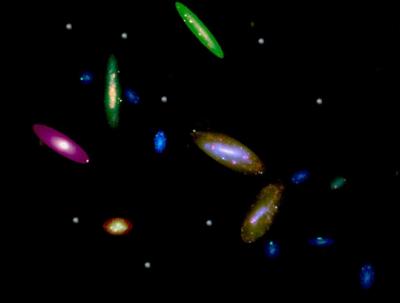Ponder the image below, which scientists at Tel Aviv University are interpreting in terms of the structure of the universe itself. The work draws on the well established notion that large galaxies are found on bubble-like structures — the soap bubble analogy is inevitable — with smaller dwarf galaxies scattered along the bubble surface. The Tel Aviv team thinks it has discovered visible traces of a filament of dark matter around which galaxies form. Filaments would be found at the juncture of two bubbles where the membrane is presumably thickest.

Thus the image, which shows fourteen galaxies studied at the university’s Wise Observatory. Here the galaxies are thought to stretch along a line extending from the lower right to the upper left corner. In its paper, the team calls the grouping “…a single kinematically well-behaved ensemble.” The area studied is intriguing not only because the galaxies found here seem to be forming in a line, but also because thirteen of them show new star formation. That latter fact drives the possibility that the galaxies are indeed forming on a dark matter filament, one that would attract new baryonic matter that then forms into stars. (Image credit: AFTAU).
The paper presents extensive observational data to support this dark matter (DM) conclusion:
We propose that the observational evidence argues in favor of interpreting the galaxies as located on a DM filament that is itself located in a low-galaxy-density region, and is accreting intergalactic cold gas focused by the filament. We are therefore witnessing in the classical NGC 672 and NGC 784 groups of relatively bright and nearby late-type galaxies the basic phenomenon of hierarchical clustering, the direct formation and growth of small galaxies out of intergalactic gas accreted on a dark matter “backbone”. This nearby galaxy collection offers, therefore, an ideal opportunity to study the phenomenon of hierarchical clustering in significant detail.
If the Tel Aviv team is correct, then what we are seeing here is the first stage of the clustering of matter that will eventually form into a major galaxy. Noah Brosch, who is director of the university’s Wise Observatory, emphasizes that the phenomenon is occurring at relatively close hand. “Our studies show that you don’t need to go to the edge of the universe to find dark matter,” says Brosch. “It may be only 15 million light years away, more or less in our backyard.” Close enough for an advanced civilization to get a mission to one day? Brosch is surprisingly sanguine about not just interstellar but intergalactic travel: “Our technology is abysmally limited right now, but it could definitely happen.”
The paper is Zitrin and Brosch, “The NGC 672 and NGC 784 Galaxy Groups: Evidence for Galaxy Formation and Growth Along a Nearby Dark Matter Filament,” in press at Monthly Notices of the Royal Astronomical Society and available online.


Hi Paul
Need a LeGuin-style NAFAL drive to travel such distances even at near-cee. Too much intergalactic junk on the way ;o)
Hi Paul and Adam;
An interesting possibility regarding the dynamics of Cold Dark Matter evolution might entail the possibility that the CDM or a portion thereof may decay into baryonic matter over periods of time equal to m(Tu) where m is greater than one and Tu is the age of the universe.
Any such CDM decay modes might permit the continuance of active and vigorous star and galaxy formation over time periods equal to m(Tu) into the future.
Perhaps CDM comes in more than one species and perhaps even more than one class thus providing a richness to the number of qualitative thermodynamic degrees of freedom within the interstellar and intergalactic medium.
Any such additional degrees of freedom might in some way be related to the Dark Energy: perhaps even the nature of and/or the existence of the CDM might have some causual coupling to the density of Dark Energy and the expansion rate change of our universe.
Regarding near C travel, I still like to hang on to the concept of the interstellar ramjet. Eventhough the current thinking on interstellar ramjets, if I am not mistaken, holds that their terminal gamma factors are considerably less than those often quoted in popular mainstream science publications such as Carl Sagan’s “Cosmos” during the 70s and 80s, I like to hang on to the possibility that some improvements in ISR concepts could some how permit the 56 year shiptime circumnavigation of the currently observable universe utilizing a constant one Earth G acceleration.
Regardless, I have hope that we can eventually travel to these CDM filaments.
In a way, CDM reactions/decays may be another source of cosmic energy just as nuclear fusion is. Understanding and mapping the cartography of CDM matter probably has strong implications for future human interstellar and intergalactic space travel.
Thanks;
Jim
Giant simulation could solve mystery of dark matter
KurzweilAI.net Nov. 6, 2008
*************************
The international Virgo Consortium,
a team of scientists, has used a
massive computer simulation showing
the evolution of a galaxy like the
Milky Way to simulate detection of
gamma rays given off by dark matter.
A map of the dark matter in six
halos similar to that of the Milky
Way. The brighter colors correspond
to regions of higher density…
http://www.kurzweilai.net/email/newsRedirect.html?newsID=9663&m=25748